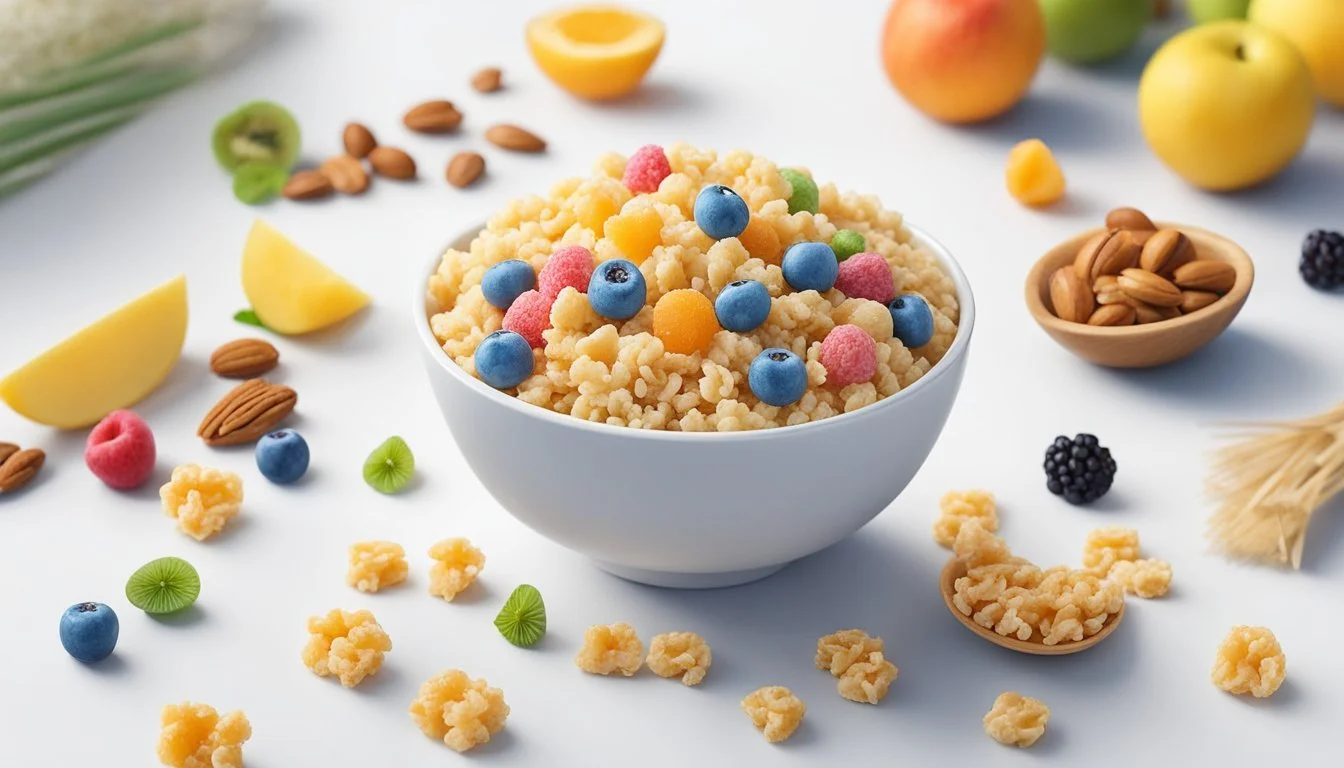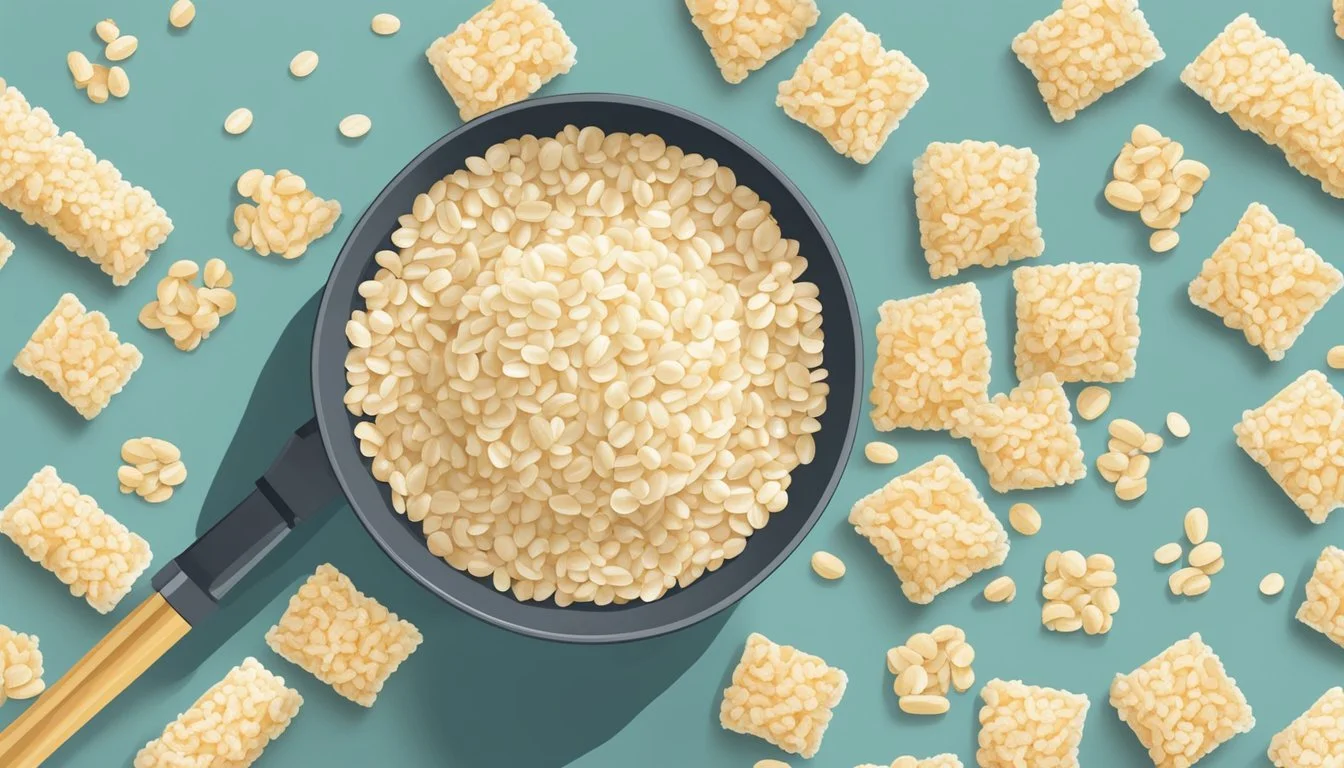Are Rice Krispies Gluten-Free?
Unveiling the Facts on Cereal Ingredients
Rice Krispies, a popular breakfast cereal made from rice, which is a naturally gluten-free grain, often sparks a common question as to whether it is safe for individuals with gluten sensitivities or celiac disease. While rice itself does not contain gluten, the traditional recipe of Rice Krispies cereal includes malt syrup, derived from barley, which does contain gluten. Consequently, the classic Rice Krispies produced by Kellogg's are not suitable for a gluten-free diet, posing a risk for those with gluten-related disorders.
In 2011, Kellogg's introduced a gluten-free version of their Rice Krispies, addressing the demand for gluten-free diets. However, this variety was discontinued a few years later in the United States. Despite this, the gluten-free formulation of Rice Krispies remained available in Canada, offering a similar taste profile without the gluten. For consumers in the United States seeking gluten-free alternatives, several other brands offer similar products made with rice and other gluten-free ingredients, providing a safer option for their dietary restrictions. It is essential for consumers to check for certification and labels to ensure that these alternatives meet the strict gluten-free standards and are free from cross-contamination.
What Are Rice Krispies?
Rice Krispies, a popular breakfast cereal, are known for their distinctive snap, crackle, and pop sounds when milk is added. They mainly consist of crisped rice and are traditionally enjoyed by various age groups across many households.
Origins and Ingredients
Rice Krispies originated as a product of Kellogg's in the 1920s. The cereal is made primarily from rice, which undergoes a cooking, drying, and toasting process to achieve its crisp texture. The primary ingredients of Rice Krispies constitute:
Rice: Serves as the main ingredient.
Sugar: Adds a touch of sweetness.
Salt: Used in moderation to enhance flavor.
Malt Flavor: Derived from barley, it imparts a distinct taste.
Traditional Rice Krispies Composition
When considering the traditional composition of Rice Krispies, one should note the following:
Rice is naturally gluten-free and forms the base of the cereal.
Malt Flavor, however, may contain gluten, as it is sourced from barley.
Additional ingredients like sugar and salt are typically considered gluten-free.
The original Rice Krispies may not be fully gluten-free due to the addition of malt flavor. Those with gluten sensitivities should look for variations labeled as gluten-free or specific gluten-free brands.
Understanding Gluten
Gluten is a protein found in specific grains and plays a vital role in the texture of foods. It is also central to various health concerns, such as celiac disease and gluten sensitivity.
The Role of Gluten in Foods
Gluten, composed primarily of the proteins glutenin and gliadin, is found in wheat, barley, and rye. It acts as a binding agent, giving elasticity to dough and allowing it to rise during baking. In foods, gluten's unique properties contribute to the chewy texture of bread, the firmness of pasta, and the stability of cakes. The use of gluten in food production is widespread due to its versatile culinary benefits.
Elasticity: Gluten helps dough stretch and traps air bubbles during fermentation.
Shape: It provides structure, enabling baked goods to maintain their shape.
Texture: Gluten contributes to the chewy texture in baked products like bread.
Gluten and Health Concerns
Gluten poses health issues for individuals suffering from conditions like celiac disease or non-celiac gluten sensitivity.
Celiac Disease: An autoimmune disorder where the ingestion of gluten leads to damage in the small intestine. Gluten consumption can trigger an immune response that damages the lining of the small intestine, which affects nutrient absorption.
Condition Trigger Reaction in Body Celiac Disease Gluten Immune response, small intestine damage
Gluten Sensitivity: People with gluten sensitivity may experience symptoms similar to celiac disease, but without the intestinal damage. Symptoms can include bloating, diarrhea, constipation, and fatigue.
Sensitivity Type Symptoms Non-Celiac Gluten Sensitivity Bloating, diarrhea, constipation, fatigue
Given the prevalence of these conditions, "gluten-free" products are essential for affected individuals. These products avoid ingredients that contain gluten, eliminating the protein's adverse effects. For instance, gluten-free bread uses alternative flours such as rice or almond flour to prevent reactions.
It's important to note that gluten is considered an allergen, and thus, food packaging often includes labels indicating whether a product is gluten-free or contains gluten substances.
The Gluten Content in Rice Krispies
Understanding the gluten content in Rice Krispies is critical for individuals with gluten sensitivities or celiac disease. Two major factors potentially contribute to the gluten content: barley malt flavoring and cross-contamination during manufacturing.
Barley Malt Flavoring and Gluten
Traditional Rice Krispies may contain barley malt flavoring. This additive, derived from barley, contains gluten, which makes the standard Rice Krispie cereals unsuitable for a gluten-free diet. Specifically, malt flavor is often used to enhance the taste, but it introduces hidden gluten into the cereal, posing a risk to those who must avoid gluten for health reasons.
Cross-Contamination Issues
Even if a cereal does not contain gluten ingredients directly, cross-contamination can occur. This happens if gluten-free products are produced in a facility that also processes gluten-containing goods. Here, tiny particles of gluten can inadvertently be mixed with gluten-free ingredients, contaminating products like rice-based cereals. Consumers should look for "certified gluten-free" labels to ensure the absence of cross-contamination.
Labeling and Gluten-Free Certification
Understanding product labels and certifications is crucial for those with celiac disease or gluten sensitivities when selecting foods like Rice Krispies. It ensures the avoidance of gluten-containing ingredients and the presence of any potential cross-contamination.
Reading Product Labels for Gluten
Consumers should scrutinize the ingredient list and allergy information on product packaging for indications of gluten. The law requires foods labeled with “gluten-free,” “free of gluten,” “no gluten,” or “without gluten” to contain less than 20 parts per million (ppm) of gluten. Specifically, one should look for labels on the packaging that explicitly denote the item as "gluten-free."
Ingredients to avoid include: wheat, barley, rye, malt, brewer's yeast, and oats (unless labeled gluten-free).
Cross-contamination warnings: These are crucial as they indicate the presence of gluten in the facility or during the manufacturing process.
Gluten-Free Certification and Seals
The Gluten-Free Certification Organization (GFCO) is one of the leading entities that certify products as gluten-free. Products that carry the GFCO’s certification seal are tested to meet strict gluten-free standards.
Certification seals on packaging serve as a guide to easily identify products that have been verified by a third party.
These seals are important as they provide an additional level of assurance beyond ingredient listing for those with celiac disease or gluten sensitivities.
The Food and Drug Administration (FDA) also plays a role in the regulation of gluten-free labeling. A product may carry a gluten-free label if the FDA's criteria are met, providing a standardized understanding for consumers across the United States.
Alternatives to Rice Krispies
For those seeking gluten-free cereal options similar to Rice Krispies, a variety of brands offer comparable products made with gluten-free ingredients. These alternatives often feature whole grains and organic components to cater to health-conscious consumers and those with dietary restrictions.
Gluten-Free Cereal Options
Gluten-free cereals are available in diverse forms, ranging from puffed rice to brown rice cereal. Key considerations for gluten-free products include the absence of barley, wheat, and rye. Many gluten-free cereals also prioritize organic ingredients and include whole grains for added health benefits. When choosing a gluten-free version, it’s important to check for certifications to ensure the absence of gluten contamination.
Brands Offering Gluten-Free Rice Cereals
Several brands have stepped up to offer gluten-free cereal alternatives to the traditional Rice Krispies:
One Degree Organic Foods: Offers a product called One Degree Brown Rice Crisps Cereal, which is gluten-free, organic, and made with brown rice.
Nature’s Path: Known for a variety of organic cereals, Nature’s Path provides gluten-free crisp rice cereal options.
Erewhon: Specializes in organic and gluten-free cereals, including their Crispy Brown Rice Cereal which is free of gluten.
Aldi: Their own brand includes Aldi Crispy Rice Cereal, a gluten-free alternative to Rice Krispies.
Barbara’s: Offers brown rice cereal options that are gluten-free, catering to those sensitive to gluten.
When searching for gluten-free cereal, these brands provide reliable alternatives that aim to maintain the taste and texture of traditional crisped rice while offering a safe choice for those with dietary restrictions.
Making Gluten-Free Rice Krispies at Home
Creating gluten-free versions of traditional Rice Krispies treats requires careful selection of ingredients and adherence to a gluten-free recipe. This section provides the necessary steps and considerations for making these delicious snacks safe for those with gluten sensitivities.
Gluten-Free Rice Krispies Treats Recipe
Ingredients:
6 cups gluten-free rice cereal
4 cups mini marshmallows
3 tablespoons unsalted butter or almond butter for a nutty twist
Pinch of salt (optional)
1 teaspoon vanilla extract (optional)
Directions:
Prepare the Pan:
Line a 9-inch x 13-inch baking pan with parchment paper.
Lightly grease the parchment paper with a neutral-flavored cooking spray.
Melt the Ingredients:
In a large pot over low heat, melt the butter.
Add in marshmallows and stir until completely melted.
Combine:
Remove the pot from heat.
Stir in vanilla and salt if using.
Immediately add the gluten-free rice cereal and stir until well coated.
Press into Pan:
Pour the mixture into the prepared pan.
Using a piece of wax paper or a spatula, press the mixture down evenly.
Cool:
Allow the treats to cool to room temperature before cutting into squares.
Selecting Safe Ingredients
The key to ensuring that Rice Krispies treats are gluten-free lies in the selection of ingredients.
Gluten-Free Rice Cereal: Not all rice cereals are gluten-free as some may contain malt flavoring derived from barley, which contains gluten. Check for a "gluten-free" label on the cereal's packaging.
Marshmallows: These are generally gluten-free, but it’s important to read labels to ensure they do not contain any gluten-containing ingredients or have been subject to cross-contamination.
Butter or Almond Butter: Regular unsalted butter is naturally gluten-free. When selecting almond butter, confirm that it has not been cross-contaminated with gluten-containing products.
By following a safe recipe and selecting gluten-free ingredients, one can make delicious Rice Krispies treats that everyone can enjoy without the risk of gluten exposure.
Texture and Taste Comparison
When comparing traditional and gluten-free Rice Krispies, it's essential to consider both texture and taste, as these aspects are crucial for consumer satisfaction and can vary significantly across different varieties.
Comparing Traditional and Gluten-Free Varieties
Traditional Rice Krispies Traditional Rice Krispies have a characteristic snap, crackle, and pop that many consumers are familiar with. Made primarily from rice, which naturally does not contain gluten, these cereals are nonetheless not gluten-free due to the inclusion of malt flavoring derived from barley. Barley contains gluten, which is a concern for those with gluten intolerance or celiac disease. In terms of taste, traditional Rice Krispies are slightly sweet with a hint of malt flavor.
Aspect Traditional Rice Krispies Texture Crispy, light, with a notable crunch Taste Slightly sweet, malt flavoring Grains Rice with added barley (contains gluten) Dietary Not suitable for gluten-free or celiac diets
Gluten-Free Varieties Gluten-free Rice Krispies varieties replace malt flavoring with alternative ingredients that mimic the original taste without containing gluten. These versions often use whole grain brown rice to maintain nutritional value, including fiber and proteins, which may offer a slightly nuttier flavor compared to the original. Gluten-free options are suitable for those avoiding wheat, rye, and barley.
Aspect Gluten-Free Rice Krispies Varieties Texture Aim to match the crispness of traditional versions Taste Close to original, may have a nuttier note Grains Whole grain brown rice, no wheat, rye, or barley Dietary Suitable for gluten-free and vegan diets
Ensuring Satisfactory Texture and Flavor
Manufacturers of gluten-free Rice Krispies put special emphasis on ensuring that the texture and taste meet consumer expectations. For texture, the goal is to retain the crispness and lightness that consumers expect from rice-based cereal. While some may notice a minor difference in crispness, efforts are made to minimize this discrepancy.
In terms of flavor, alternate sweeteners and gluten-free flavorings are used to closely replicate the original taste profile. While whole grain brown rice can impart a slightly different taste, the overall experience is intended to remain satisfying for those who prefer or require a gluten-free diet. Brands may vary in their specific formulations, but the common aim is to produce a gluten-free cereal that does not feel like a compromise on the sensory experience of eating Rice Krispies.
Nutritional Considerations
When discussing the nutritional profile of Rice Krispies and gluten-free cereals, it's essential to address the advantages of whole grains in a diet and the contribution of essential vitamins and minerals.
Benefits of Whole Grains in the Diet
Whole grain rice serves as a nutritious staple that provides several health benefits. It is a rich source of dietary fiber, which supports digestive health and can contribute to a feeling of fullness. Including whole grains like brown rice in one's diet may also reduce the risk of chronic diseases and help with weight management.
Vitamins and Minerals in Gluten-Free Cereals
Gluten-free cereals often include supplemental vitamins and minerals to match the nutritional benefits of their gluten-containing counterparts. Essential B vitamins, often added to enhance nutritional value, play a vital role in energy metabolism and neurological functions. Minerals like iron and folic acid are also commonly fortified in these cereals. Gluten-free cereals may contain a variety of ingredients such as cane sugar for sweetness, sea salt for flavor enhancement, and molasses as a source of iron and calcium.
Navigating Gluten Sensitivities
Navigating gluten sensitivities, such as celiac disease and gluten intolerance, requires careful diet management and an understanding of what products contain gluten. This necessitates a diligent assessment of food labels and awareness of cross contamination.
Living with Celiac Disease and Gluten Sensitivity
Individuals diagnosed with celiac disease require a strict gluten-free diet, as exposure to gluten triggers an immune response that can damage the intestines. Similarly, those with gluten sensitivities, although not as severe as celiac disease, must avoid gluten to prevent symptoms like bloating, headaches, and fatigue.
Key Considerations:
Read Labels: Always review product labels for gluten-containing ingredients.
Watch for Cross-contamination: Be aware that gluten-free products can become cross-contaminated with gluten in shared facilities.
Identifying and Avoiding Gluten in the Diet
Proper identification of gluten in the diet is crucial. Foods like wheat, barley, and rye contain gluten.
Common Sources of Gluten:
Wheat and wheat derivatives
Barley, including malt flavoring
Rye
To mitigate the risks of consuming gluten:
Choose Certified Gluten-free Products: Especially for those with celiac disease, to ensure the product is safe.
Prepare Food Safely: Use separate cooking and food preparation areas to prevent cross-contamination.
Communicate Dietary Needs: When dining out, individuals should inform staff of their gluten sensitivities to avoid accidental ingestion.
Regional Considerations and Availability
The availability of gluten-free Rice Krispies varies globally, and labeling often differs by country. Consumers need to carefully examine product labels for gluten content, particularly when dealing with international brands or traveling abroad.
Availability of Gluten-Free Rice Krispies Worldwide
Internationally, gluten-free Rice Krispies offerings can differ. For instance, Kellogg's Rice Krispies in the United States are not gluten-free due to the presence of malt syrup, which contains barley, a source of gluten. However, there have been gluten-free versions on the market in the past. Consumers seeking gluten-free options might find them under different brand names or regional variants that do not contain malt flavoring.
Some countries may have certified gluten-free rice cereals which can be safe alternatives for individuals with celiac disease or gluten sensitivity. These products typically bear a gluten-free label and have undergone verification to meet the local criteria for the absence of gluten.
Country-Specific Formulations and Labels
In Canada, Kellogg's offers Rice Krispies that similarly contain malt flavoring, and therefore, are not gluten-free. However, Canadian product lines might offer alternatives that are certified gluten-free, which undergo stringent testing to meet national standards for gluten-free certification.
Packaged Rice Krispies Treats, which are pre-made and sold by Kellogg’s, might also contain gluten. As with cereals, these products may vary by country and should be evaluated based on the packaging and local regulations concerning gluten labeling.
Consumers are advised to:
Look for "gluten-free" claims on the label.
Verify if the product is certified gluten-free, which can add an extra layer of assurance.
Check for any advisory statements that might indicate potential cross-contamination with gluten-containing ingredients.
By staying informed and cautiously reading labels, those requiring gluten-free diets can navigate the variable landscape of Rice Krispies' gluten-free status.








